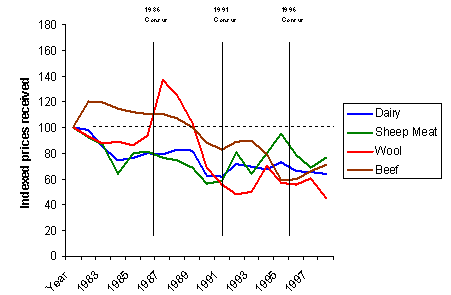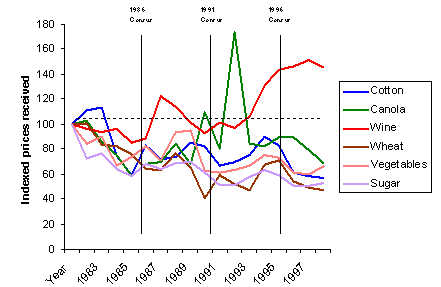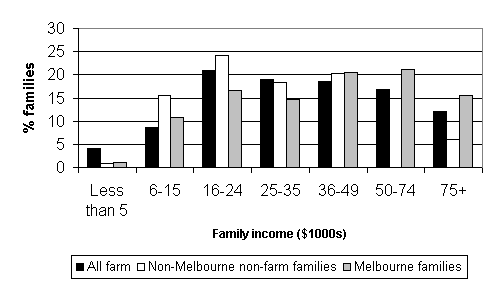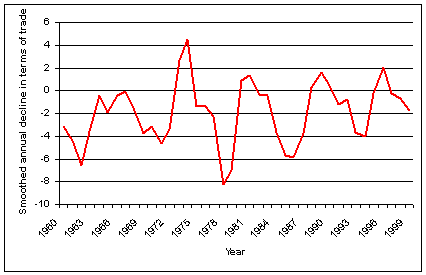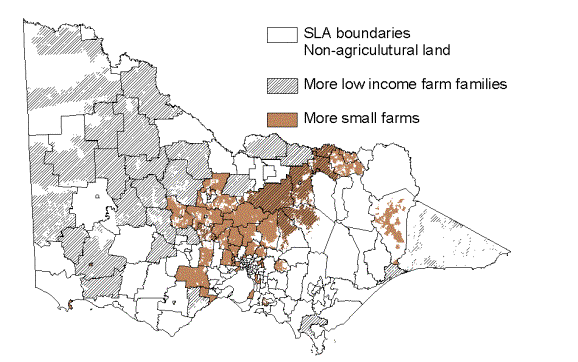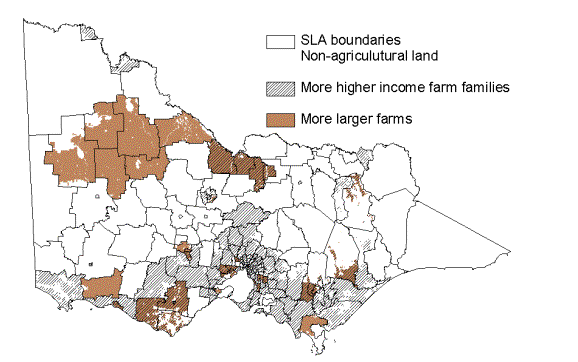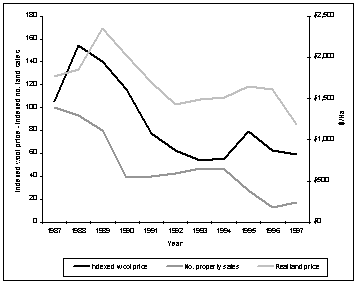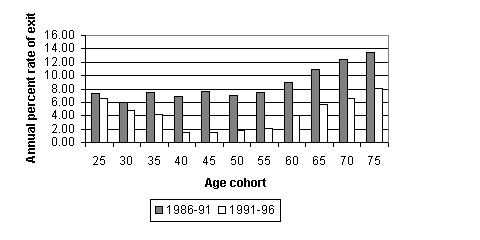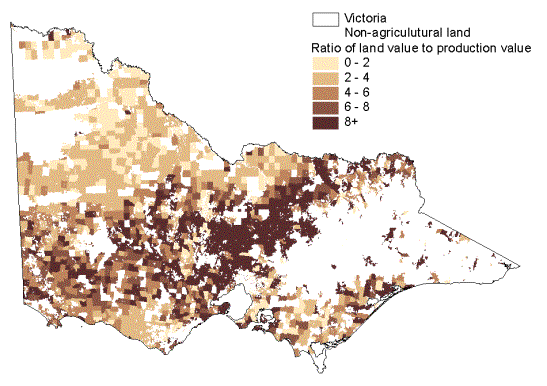| Connections |
| Home |
| Index
of Papers |
| Guidelines |
|
Connections - Farm, Food and Resource Issues |
|
Going On The Land – And Getting Off It: Farm Incomes And Farm Adjustment Neil Barr[1] Department
Of Natural Resources And Environment, Rural incomes are not farm incomes Income instability and the high media profile of farm income issues Are low farm incomes a welfare or work satisfaction issue? Is the persistence of small farms due to a lack of exits or too many entrants? The movement of people out of farming, and into it, and the livelihood of farmers relative to non-farmers have long been subjects of considerable interest and importance in agricultural, political, social and economic debate in Australia. This paper was a response to a request for some reflections on the “farm income problem”. It reviews some of the findings of recent research into the patterns of structural adjustment in contemporary Australian agriculture. Readers seeking further detail are directed to (Barr and Karunaratne 2002; Barr, Wilkinson and Karunaratne 2002; Barr 2001) Rural incomes are not farm incomes In my work for the National Land and Water Resources Audit I was asked to consider ‘capacity to change’ to more ‘sustainable’ farming systems. One way of approaching this question was to look at farm family income. Deciding to take the simple approach I used the Australian Population and Housing Census. The most recent census in 1996 was a period of ‘average’ real commodity prices for many industries. Wine grape prices were clearly above the long term price trend and wool was below the long term trend (Figure 1). A
simple histogram comparison of farm family and Australian family incomes
showed a great deal of similarity. The reaction to this was surprising.
Reviewers questioned the results. When I asked for reviewers to send me the
evidence that this data was wrong, two issues emerged. One was the obvious
widespread media image of hard times on the farm. We have all heard these
stories in the general media. I am now hearing many of the good income
stories, but mostly on the Country Hour. While many of my colleagues had
heard the general media stories, few listened to the Country Hour. I also
received a number of articles that reported a substantial difference in
income between rural and urban Australia. It became clear that for some of
my reviewers the terms ‘rural’ and ‘farm’ were inter-changeable.
Farmers are not only a minority of Australians, but also a minority of rural
Australians. Farmers as a group also generally have higher average incomes
than the rest of the rural population that includes many low income earners
in rural towns (Figure 2 portrays income distributions for Victorian farm
families, Melbourne families and other rural Victorian families). Tony
Gleeson has written of the widespread unjustified interchangeability of the
words “rural” and “farm” in popular policy debate
(Gleeson 2000)
. This confusion is to
the advantage of some players in this debate. There is poverty in both farm
and non-farm sectors of the Australian community. The farm constituency is
in danger of overplaying its hand if it argues for special consideration Figure 1: Indexed prices received for major agricultural commodities 1981-1999 (Source ABARE)
Figure 2: Victorian family incomes and farm family incomes 1996 (Source: ABS Population and Housing Census 1996)
Income instability and the high media profile of farm income issues There
is a wealth of research literature establishing a link between low incomes
and indicators of well-being including raised mortality
(Kaplan and Lynch 1997)
. Research on the link
between income stability and well-being is uncommon because of the paucity
of data sets with longitudinal income and well-being information. One of the
best data sets is the Panel Study of Income Dynamics that has tracked the
trajectories of 5,000 US families over more than 30 years
(Duncan 1999)
. The PSID data has shown
that income variability also significantly increases mortality risk, but
only in the middle classes
(McDonough
et al. 1997)
. One explanation of this
is that the disadvantages of low incomes and the advantages of high incomes
overwhelm the effect of income variability. The risks of income variability
are greatest for the middle classes. Presumably increased risk of mortality
is an indicator of less severe disorders such as stress and depression. This
research finding is particularly relevant to the farm community. Farm
families can be described as having a middle class income profile. Farm
incomes are characterised by high variability (Figure 3). As part of the
National Land and Water Resources Audit John Cary used income and farm
practice data from ABARE to look at predictors of adoption of changed farm
practices. He found perceptions of future income stability was a better
predictor of behaviour than actual income
(Cary et al. 2001)
. In previous work with
Victorian dairy farmers Ruth Weston found stress attributed to poor incomes
was only marginally related to income, but was strongly related to how
incomes were construed
(Weston and Cary 1979)
. The sense of income
future and security is strongly mediated by personality factors as well as
the environment. There is some emerging evidence that farmers may well have
a limited number of personality sets, some of which may be incompatible with
current policy towards both risk management behaviour and community group
program delivery
(Shrapnel and Davie 2000)
. These
findings raise an interesting question for both industry policy and natural
resource policy. Industry deregulation is justified by its potential to
increase aggregate industry income. Presumably increased income is justified
by the improvement in quality of life this affords. Is it possible we may
increase income overall, but may increase dissatisfaction and sense of
well-being at the same time? It may also explain the media profile of farm
family welfare issues. Figure 3: Rate of change in Australian farmers terms of trade (5 year smoothed)
(Derived from ABARE data) Are low farm incomes a welfare or work satisfaction issue? Small
farms dominate the count of Australian farms. Despite their numbers small
farms contribute little to total value of production. Using data from the 1997 Agricultural Census we can talk
about a 10-50 rule. The largest 10 per cent of farms produced 50 per cent of
the total value of production. The obverse was also true. The smallest 50
per cent of farms produced ten per cent of the total value of production. Despite
the large number of small farms, it cannot be assumed this indicates the
existence of a welfare problem. In Victoria there is very little
relationship between farm family income and farm size. Areas with larger
numbers of small farms often had the largest average farm family incomes
(Figure 4 and Figure 5). During
much of the 1990s farm family incomes were dependent on off-farm employment
in many industries during much of the commodity price cycle
(Rasheed, Rodriguez and
Garnaut 1998)
. In industries such as
beef or wool production, rural concern over poor commodity prices might have
been construed not as an income problem but as a job satisfaction problem. Figure 4: Comparison of the geographic distributions of small farms and low farm family incomes averaged over three censuses (1986, 1991 and 1996)
Figure 5: Comparison of the geographic distributions of larger farms and higher farm family incomes averaged over three censuses (1986, 1991 and 1996)
Is the persistence of small farms due to a lack of exits or too many entrants? The inexorable pressure of terms of trade in agriculture is generally downwards in the longer term. Continuing productivity improvements in agriculture, competition for resources and relatively inelastic demand for many agricultural products drives this pressure. Farming has been likened to surfing in front of the terms of trade wave. Striving for productivity improvements keeps one in front of the wave. But the aggregate effect of the striving by agricultural producers is to fuel the wave’s continued progress (Owen 1966) . Capturing productivity gains is one means of keeping ahead of the terms of trade decline. For broadacre businesses productivity improvements can come in many forms. There is accumulating evidence that it is the largest Australian farms that are capturing much of the productivity improvements in agriculture (Ha and Chapman 2000; O'Neill and Strappazzon 2000; Australasian Agribusiness Services 1997; Knopke, Strappazzon and Mullen 1995) . These researchers estimate much of the productivity improvement is captured by the largest third of farms or even the largest 10 per cent of farm businesses. The smallest third of farms are capturing very little productivity increase. Conventional analysis of agricultural adjustment would suggest that the lack of productivity gains in the small farm sector will lead to the gradual disappearance of the sector. (Jackson-Smith 1999) described this implicit model thus: Over time most analysts have adopted an implicit model of structural change that is driven by the relative economic viability of different types of farms. A focus on competition in the market place as a key mechanism for structural change has led to the common, but largely untested, belief that most change occurs via the involuntary exit of farmers who could not compete, and the (inevitable) adaptations of those who remain in business. Farm entry is a major factor inhibiting farm amalgamation. While
the average annual rate of decline in the number of Australian farmers was
2.1 per cent between 1986 and 1996, the national annual rate of entry was
3.5 per cent and the national annual rate of exit was 5.7 per cent. The
pattern of entries and exits is not consistent across rural Australia. Rates
of entry and exit in the cropping zone are low. These areas can truly be
described as ‘tightly held’. Rates of entry are high in the rangelands
and in higher amenity regions where there is an abundance of small farm
establishments (for example in proximity to many major regional centres).
The high rates of entry to farming in amenity regions are consistent
with the finding of researchers in north America and Europe that the desire
to enter farming is strong despite the riskiness of the profession. New
entrants have lower equity and are less buffered against fluctuating
commodity prices and seasonal conditions. Higher levels of debt make these
new businesses much more likely to fail
(Lindsay and Gleeson 1997)
. Despite these risks, there is a continuing interest in entering farming,
often based upon unrealistic expectations of the chance of success
(Stayner 1997; Reeve and Kaine 1996)
. Poor commodity prices will not immediately accelerate exits from farming Figure 6 shows the behaviour of the land market in Victoria’s wool producing areas during the 1980s and 1990s. This gives another insight into the selling behaviour of owners of small properties. What we see in this graph is potential vendors hanging on through the lows of the price cycle till they get their superannuation cashed out when commodity prices rebound. Farm amalgamation was limited. Reasons for this limited occupational mobility can be explained by rational behaviour choices of Victoria’s wool producers. Figure 6: Wool prices, wool property values and property sales in Victoria for the period 1987-97
There are clear family life-cycle and labour market based explanations for this limited occupational mobility. Many wool producers are in the middle stages of their career. An attempt to change career may well be a poor investment of their human capital. Their skills are in the sheep industry, many have limited formal education and few remaining years in which to capitalise on an investment in new skills (Clark, Kreps and Spengler 1978) . During the 1990s the regional job market offered little prospect of farmers improving their incomes. Those with off-farm work would be unlikely to improve their financial position by quitting the farm. The resulting immobility is portrayed in Figure 7. It is probable that relationship breakdown rather than direct financial pressure is the major reason for farm exit in this age group during lows in the commodity price cycle. In a study of the decision to exit farming in northern Victoria, spouse satisfaction with marriage and family life was found to be the strongest indicator of future exit decisions (Barr 1999) . For the many sheep farmers in their late career years, the farm is the asset that can provide income security in retirement. With limited prospects of improving incomes by quitting farming, any decision to sell the farm during a period of low demand for farmland would threaten retirement security. Many older farmers sensibly delay plans to sell land during periods of poor commodity prices. Older farmers whose children have decided not to enter farming as a career do not have an incentive to step aside from the farm to allow their children to take over its management. Their easiest course of action is to remain in farming for as long as they are healthy and able to enjoy it. Decisions to leave woolgrowing, or to not even enter the industry, have thus become concentrated during the early career of the following generation. For these young people, career and lifestyle opportunities in the city are much greater and more enticing than they were for their parents whose formative years may coincided with more favourable wool prices. Figure 7: Estimated annual per cent rate of exit from Victorian sheep farming by age 1986-91 and 1991-96
It is not necessarily the owners of the smallest farms who will leave in response to economic signals. An important means of capturing productivity increases is the adoption of more efficient methods of farming. These practices often require increasing the scale of farming enterprises to capture their advantages. This is particular difficult for small farms. They have a lesser capacity to generate a financial surplus and will find it difficult to compete against larger farm businesses or other new entrants. Secondly, small farms are often in regions where amenity-based land values render land purchase a poor business option. Figure 8 shows the ratio of land value per hectare to the gross value of production per hectare for agricultural land during the 1990s. Areas of high ratio correspond closely to areas where small farms occupy a relatively larger proportion of the landscape. These high ratios reflect both a high amenity value for land with attractive topography and proximity to urban services, and also the greater housing component in property values created by the closer settlement. It is logical to assume that in these areas the path to improved farm productivity through land purchase is unlikely to be an economically attractive option for broadacre agricultural activity. Interviews with Victorian farm financial counsellors generally confirm that the greatest threat to the short to medium term survival of a farm business is an ill-timed purchase of over-priced land (Madden 1996). The resulting pattern of land ownership in these areas is a combination of unstable tenure associated with farm business aspirations or stable tenure associated with lifestyle choices. An example is the Nyah irrigation district as discussed in (Barr and Cary 1992) This behaviour helps explain the observation that the extinction of farm businesses is greatest amongst mid-sized farms (see Figure 9). The disappearance of these middle-sized farms is relative rather than absolute. Bifurcation of the Australian farm sector is being caused by differential rates of farm number decline in differing areas of rural Australia. The area contributing to the relatively low rates of decline in small farm numbers is along the slopes of the Great Dividing Range and the cropping zone from North East Victoria to central Queensland. The number of small farms in this region fell little, or even rose locally between 1986 and 1996. The decline in the number of farms with Estimated Value of Agricultural Operations between $50,000 and $160,000 was most apparent across much of the ‘broadacre heartland’ of Australia. This includes the wheat belts of Victoria, South Australia and Western Australia. In these areas, farms with EVAOs between $50,000 and $160,000 are considered small farms. There are very few farms with EVAOs below $50,000. Where farm aggregation is occurring, the farms being purchased for aggregation are the middle sized rather than the smaller, mainly because there are no truly small farms in many of these areas. Figure 8: Ratio of land value to value of production in 1997 (based upon parish data supplied by ABS and the Victorian Valuer General’s office)
Figure 9: Change in number of farm establishments by Estimated Value of Agricultural Operations cohort as a per cent of all farm establishments within cohort: 1986-96(using constant 1996 dollars)
The continuing abundance of large numbers of small Australian farms has been a target of agricultural policy for a number of decades in the late 20th century. The objective of successive rural adjustment policies has been the facilitation of a restructured agriculture characterised by a far smaller number of much larger farms capable of providing a reasonable return on capital. It is now recognised that many of the policy tools used in the past to pursue this objective have been unsuccessful (McColl, Donald and Shearer 1997) . Thirty or more years of persistence with these tools is perhaps an indication of a misunderstanding of the nature of agricultural adjustment. Boehlje has summarised a number of implicit models of agricultural adjustment used by policy makers (Boehlje 1992) :
Boehlje argued that a full understanding of the process of structural change could not be achieved by relying upon less than the insights of all five models. Australian policy on agricultural adjustment has accommodated the insights of the first four of Bohelje's models, but has often had trouble accommodating the insights of the sociological model of structural change. It is possible to argue that the lack of a comprehensive understanding of the rural adjustment process has allowed thirty years of policy to be based upon unrealistic expectations of agricultural regions' potential futures and unrealistic expectations of policy interventions. With our nation having set a new policy challenge for rural regions based upon natural resource management imperatives, it would be advisable to more fully inform ourselves of the nature of adjustment in our agricultural industries and potential transformations of rural areas. Good policy will be well informed about, and deal with, real phenomenon - not poorly informed perceptions of the farm sector. Australasian
Agribusiness Services. (1997) Financial
Performance of Broadacre Agriculture, Rural Industries Research and
Development Corporation, Canberra, RIRDC 97/40. Barr,
N. (2001) Structural Change in Australian Agriculture: Implications for Natural
Resource Management - Salinity case Studies, National Land and Water
Audit, Canberra. Barr,
N. and Karunaratne, K. (forthcoming) Victoria's
small farms, Natural Resources and Environment, Bendigo. Barr,
N., Wilkinson, R., and Karunaratne, K. (forthcoming) The
changing social landscape of the Victorian wool industry: 1986-96,
Natural Resources and Environment, Bendigo. Barr,
N. F. (1999) Salinity control, water reform and structural adjustment: The Tragowel
Plains Irrigation District, Unpublished doctoral thesis thesis,
Institute of Land and Food, University of Melbourne, http://adt1.lib.unimelb.edu.au/adt-root/public/adt-VU2000.0002/
Boehlje,
M. (1992) Alternative models of structural change in agriculture and related
industries, Agribusiness, vol. 8, pp. 219-231. Cary,
J., Barr, N., Aslin, H., Webb, T., and Kelson, S. (2001) Human
and Social Aspects of Capacity to Change Sustainable Management Practices,
National Land and Water Resources Audit, Canberra. Clark,
R., Kreps, J., and Spengler, J. (1978) The Economics of Ageing, Journal
of Economic Literature 16, pp. 919-962. Duncan,
G. J. (1999) "The PSID and Me", proceedings of the paper presented
to the "Landmark Studies of the 20th Century" conference,
Northwestern University, Chicago. http://www.northwestern.edu/IPR/publications/papers/psid.pdf
Gleeson,
A. (2000) Australian Values: Rural Policies, http://www.synapseconsulting.com.au/symposium/paper.asp?id=40
Ha,
A. and Chapman, L. (2000) Productivity growth trends across Australian
broadacre industries, Australian Commodities, vol. 7, 2, pp. 334-340. Jackson-Smith,
D. B. (1999) Understanding the Microdynamics of Farm Structural Change:
Entry, Exit, and restructuring among Wisonsin Family Farmers in the 1980s, Rural
Sociology, vol. 64, 1, pp. 66-91. Kaplan,
G. A. and Lynch, J. W. (1997) Whither studies on the socio-economic
foundations of public health?, American
Journal of Public Health, vol. 87, pp. 728-729, http://depts.washington.edu/eqhlth/paperA3b.html
Knopke,
P., Strappazzon, L., and Mullen, J. (1995) Productivity Growth: Total Factor
Productivity on Australian Broadacre farms, Australian
Commodities, vol. 2, 4, pp. 486-497. Lindsay,
R. and Gleeson, T. (1997) Changing
Structure of Farming, ABARE Current Issues, Australian Bureau of
Agricultural and Resource Econimics, Canberra. Madden,
B. J. (1996) Analysing the major farm management decisions for business suvival and
growth thesis, School of Agriculture and Resource Management, University
of Melbourne. McColl,
J., Donald, R., and Shearer, C. (1997) Rural
Adjustment, Managing Change: Mid-term review of the Rural Adjustment Scheme,
Department of Primary Industry and Energy, Canberra. McDonough,
P., Duncan, G. J., Williams, D., and House, J. (1997) Income Dynamics and
Adult Mortality Adult Mortality in the U.S., 1972-1989, American
Journal of Public Health, vol. 87, 9, pp. 1476-1483. O'Neill,
T. and Strappazzon, L. (2000) Dairy Technology Adoption and Productivity: an
Empirical Analysis Owen,
W. F. (1966) The double development squeeze on agriculture, American
Economic Review, vol. 1. Rasheed,
C., Rodriguez, G., and Garnaut, J. (1998) Patterns of employment of men and
women in farming, Australian Farm Surveys Report pp. 43-47. Reeve,
I. and Kaine, G. (1996) Entry and
Expansion: Land Transactions in Agriculture, University of New England,
Armidale, TRDC Report 196. Shrapnel,
M. and Davie, J. (2000) The Influence of Personality in Determining Farmer
Responsiveness to Risk. Gatton, School of Natural and Rural Systems
Management, University of Queensland. Stayner,
R. (1997) "Getting into farming: family and financial factors",
proceedings of the Agricultural and Resources Outlook Conference, ABARE,
Canberra. Weston, R. E. and Cary, J. W. (1979) A Change for the Better: Stress, Attitudes and Decision Making of Dairy Farmers 1976 to 1978 , School of Agriculture and Forestry, University of Melbourne.
[1] This article was presented
as a paper to the AARES 2002 Pre-Conference Workshop, "Rural
Livelihoods and Adjustment."
|
